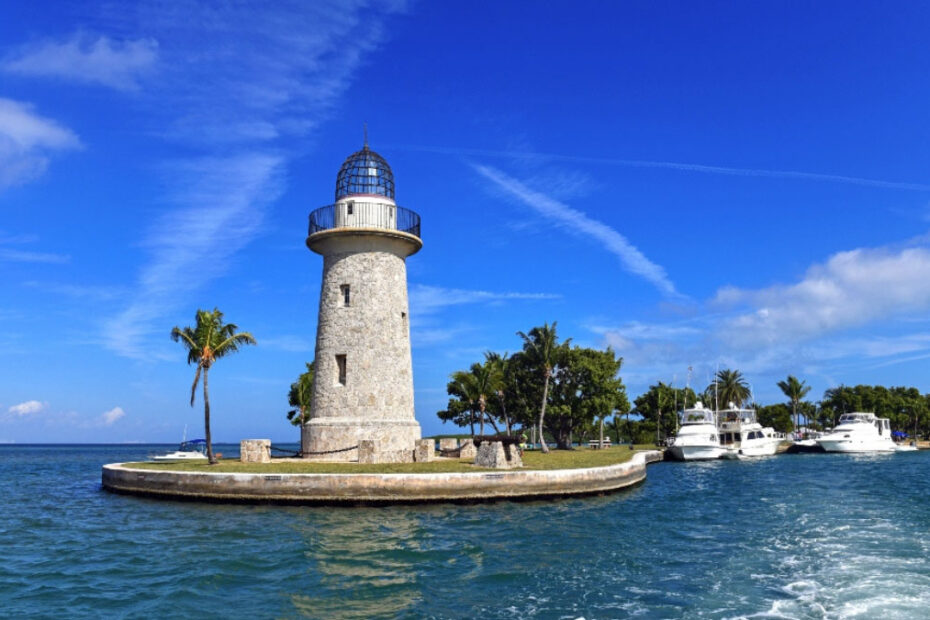Florida isn’t just about pristine beaches and bustling theme parks; it’s also home to some of the most breathtaking national parks in the country. If you’re craving a dose of nature, the Sunshine State offers a variety of landscapes, from lush wetlands to unique coastal habitats.
Whether you’re an avid hiker, a wildlife enthusiast, or someone who simply enjoys a peaceful escape, Florida’s national parks have something for everyone. Ready to explore the best of what Florida has to offer? Let’s jump into the top national parks you shouldn’t miss.
Key Takeaways
- Everglades National Park: This globally recognized subtropical wilderness is home to rare species and offers diverse attractions like the Anhinga Trail and Shark Valley. Key amenities include campgrounds and nearby hotels.
- Biscayne National Park: Located near Miami, this park combines aquamarine waters and vibrant coral reefs with historical sites. It’s perfect for boating, snorkeling, and wildlife viewing.
- Dry Tortugas National Park: Accessible only by boat or seaplane, this remote park offers unique adventures including exploring Fort Jefferson, snorkeling, and birdwatching.
- Timucuan Ecological & Historic Preserve: Located in Jacksonville, this preserve features both natural and historical attractions like Fort Caroline National Memorial and Kingsley Plantation.
- Big Cypress National Preserve: Known for its diverse habitats, this preserve offers scenic drives, camping spots, and various recreational activities like off-road vehicle trails and hiking.
- Best Time to Visit: The dry season (November to April) provides cooler temperatures and fewer mosquitoes, making it ideal for exploration. Summer brings lush landscapes but also frequent thunderstorms and higher water levels.
Overview of Florida’s National Parks
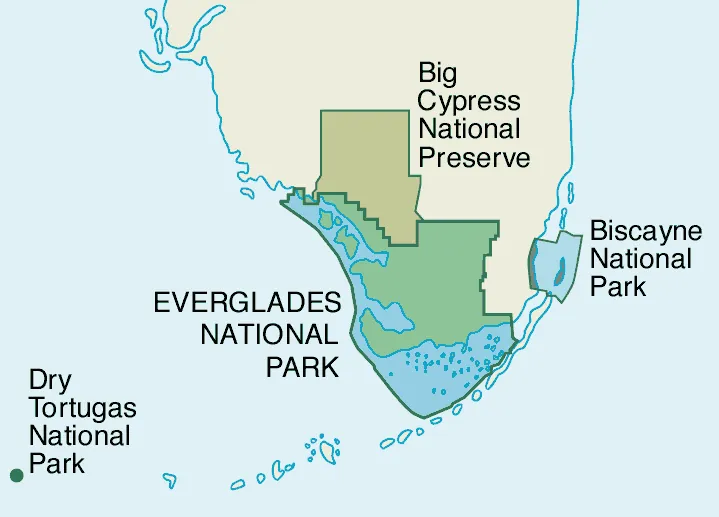
Everglades National Park
Discover the largest subtropical wilderness in the U.S. at Everglades National Park in southern Florida. It’s a haven for rare species like the American crocodile, Florida panther, and West Indian manatee. This park’s significance is recognized globally as it is an International Biosphere Reserve, a World Heritage Site, and a Wetland of International Importance.
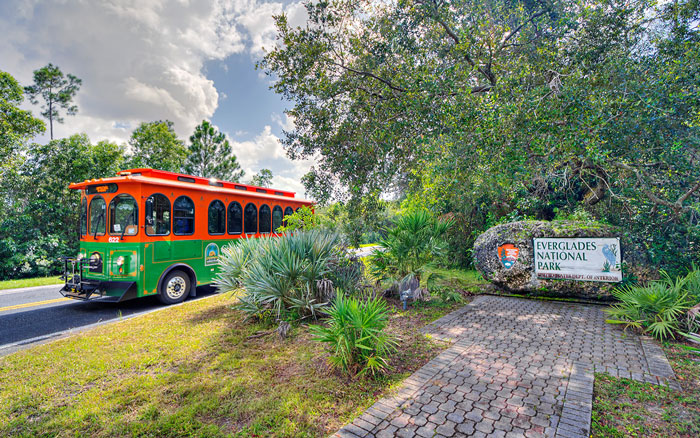
Top Attractions:
- Sawgrass marshes
- Mahogany Hammock
- Anhinga Trail
- Shark Valley
Hidden Gems:
- Pinelands trails
- Guy Bradley Visitor Center
Accommodations:
| Type | Location | Price Range | Facilities | Booking Link |
|---|---|---|---|---|
| Campgrounds | Flamingo & Long Pine Key | $15 – $35 | Restrooms, Showers, Fire pits | NPS Camping Reservations |
| Hotels | Nearby Homestead | $80 – $150 | Wifi, Parking, Pools | Homestead Hotels |
Dining Highlights:
- Local seafood at Everglades City
- Casual dining at the Flamingo Marina Store
Transportation & Practical Tips:
- Rent a car for flexibility
- Visitor centers provide maps and updates
- Bug spray is essential year-round
Biscayne National Park
Located near Miami, Biscayne National Park combines aquamarine waters, emerald islands, and vibrant coral reefs. It guards over 10,000 years of human history including remnants from prehistoric tribes and shipwrecks, offering a mix of natural and cultural explorations.
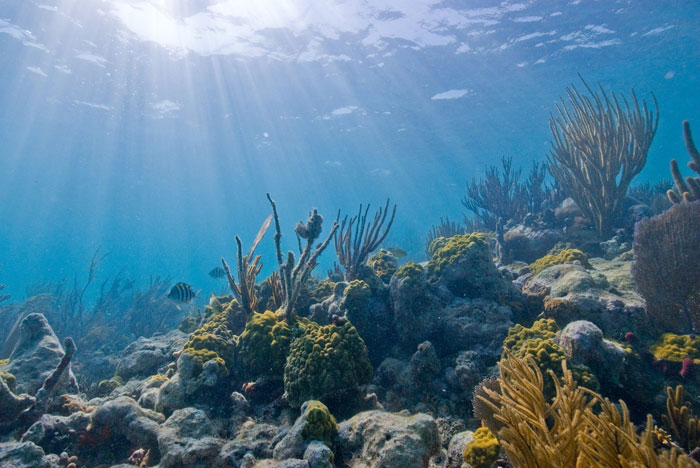
Top Attractions:
- Boca Chita Key
- Maritime Heritage Trail
- Elliot Key
Hidden Gems:
- Jones Lagoon
- Adams Key
Accommodations:
| Type | Location | Price Range | Facilities | Booking Link |
|---|---|---|---|---|
| Campgrounds | Boca Chita Key | $25 | Restrooms, Picnic Tables | NPS Camping Info |
| Hotels | Nearby Miami | $100 – $250 | Pools, Restaurants | Miami Hotels |
Dining Highlights:
- Fresh catches at the Marinas
- Cuban cuisine in nearby Miami
- Boat rentals available for exploring the park
- Snorkeling gear is a must for underwater attractions
- Check weather forecasts before planning boat trips
Florida’s national parks offer varied experiences from wetlands teeming with wildlife to underwater worlds rich in history. Each park invites you to explore its unique landscapes and stories while ensuring an unforgettable adventure.
Top National Parks to Visit in Florida
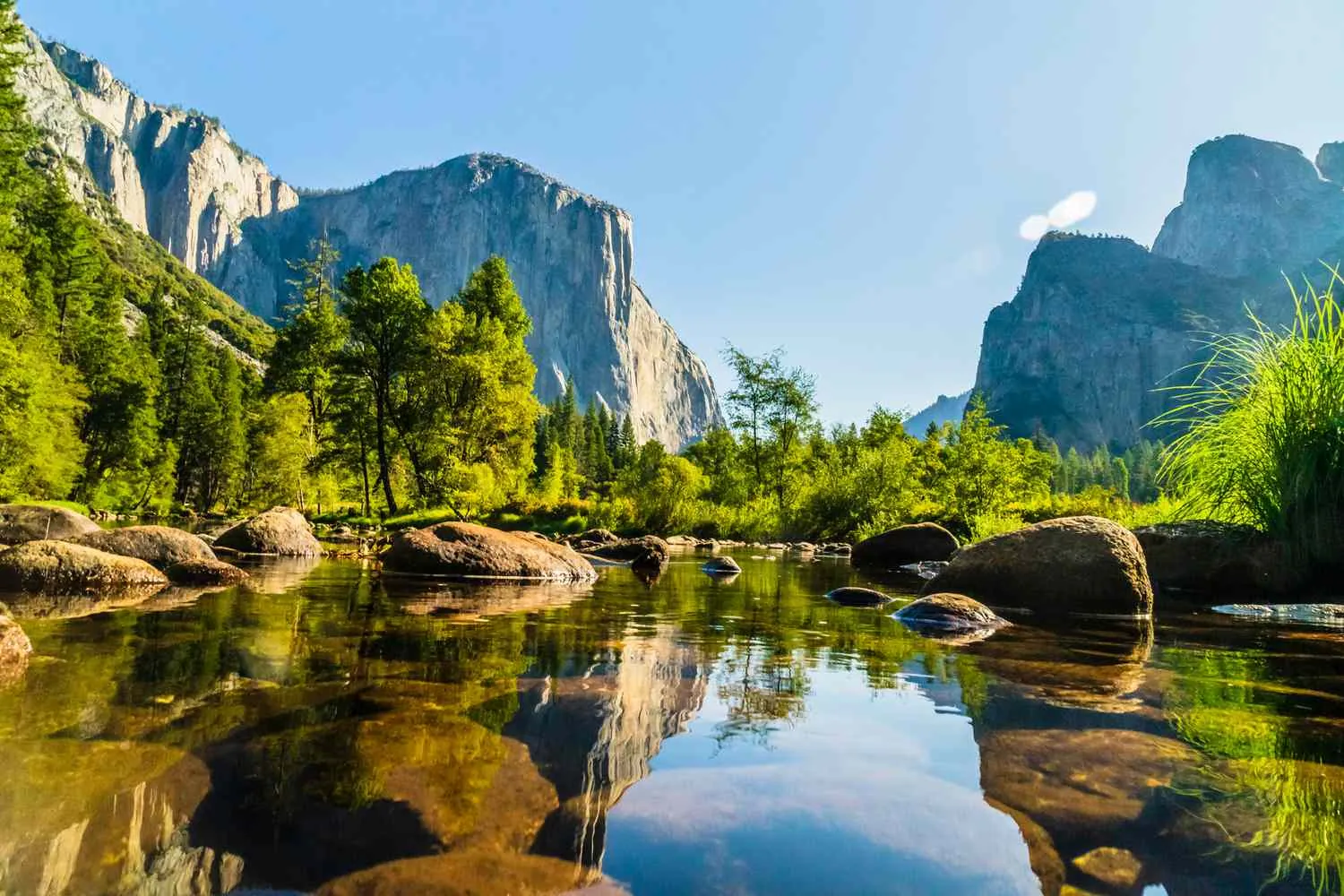
Everglades National Park
Sitting at the southern tip of Florida, Everglades National Park enthralls with its unique subtropical ecosystem and diverse wildlife. Spanning 1.5 million acres, this park promises adventure and tranquility.
Top Attractions
- Anhinga Trail: Walk this short trail for close-up views of alligators, wading birds, and other wildlife.
- Shark Valley: Climb the 65-foot observation tower for a panoramic view of the “River of Grass.”
- Gulf Coast Visitor Center: Launch off on a boat tour to explore the park’s ten thousand islands.
- Flamingo: Enjoy fishing, paddling, and stunning birdwatching opportunities.
Hidden Gems
Discover the beauty of Mahogany Hammock, a tropical hardwood forest with a boardwalk trail that meanders through deep, lush foliage. Unveil the serene expanses of Nine Mile Pond, ideal for canoeists seeking a quieter encounter with nature.
Accommodations
| Accommodation Name | Type | Features | Price Range (Per Night) |
|---|---|---|---|
| Flamingo Campground | Campsite | RV and tent sites, marina nearby | $20 – $40 |
| Long Pine Key Campground | Campsite | Quiet, surrounded by pines | $25 – $35 |
| Everglades City Motel | Motel | Comfortable, basic amenities | $70 – $150 |
| Ivey House Everglades | Bed & Breakfast | Eco-tours, pool | $100 – $200 |
Dining Highlights
Dine locally with fresh seafood at Camellia Street Grill in Everglades City, offering a riverside view and delicious stone crab claws. For a quick bite, try Havana Cafe of the Everglades, renowned for its Cuban-inspired cuisine.
Transportation & Practical Tips
Public transportation is limited, so it’s best to rent a car. Prepare for mosquitoes by packing repellent, especially during the wet season (May to November). Entrance fees are $30 per vehicle for a seven-day pass.
Historical context enriches the visit; Everglades has UNESCO World Heritage status due to its unique ecosystem. Visit during the dry season (December to April) to avoid flooding and enjoy cooler weather. For a sustainable trip, adhere to the “Leave No Trace” principles and support local businesses.
By embracing these tips, your journey through Everglades National Park promises a captivating blend of adventure, nature, and culture.
Dry Tortugas National Park
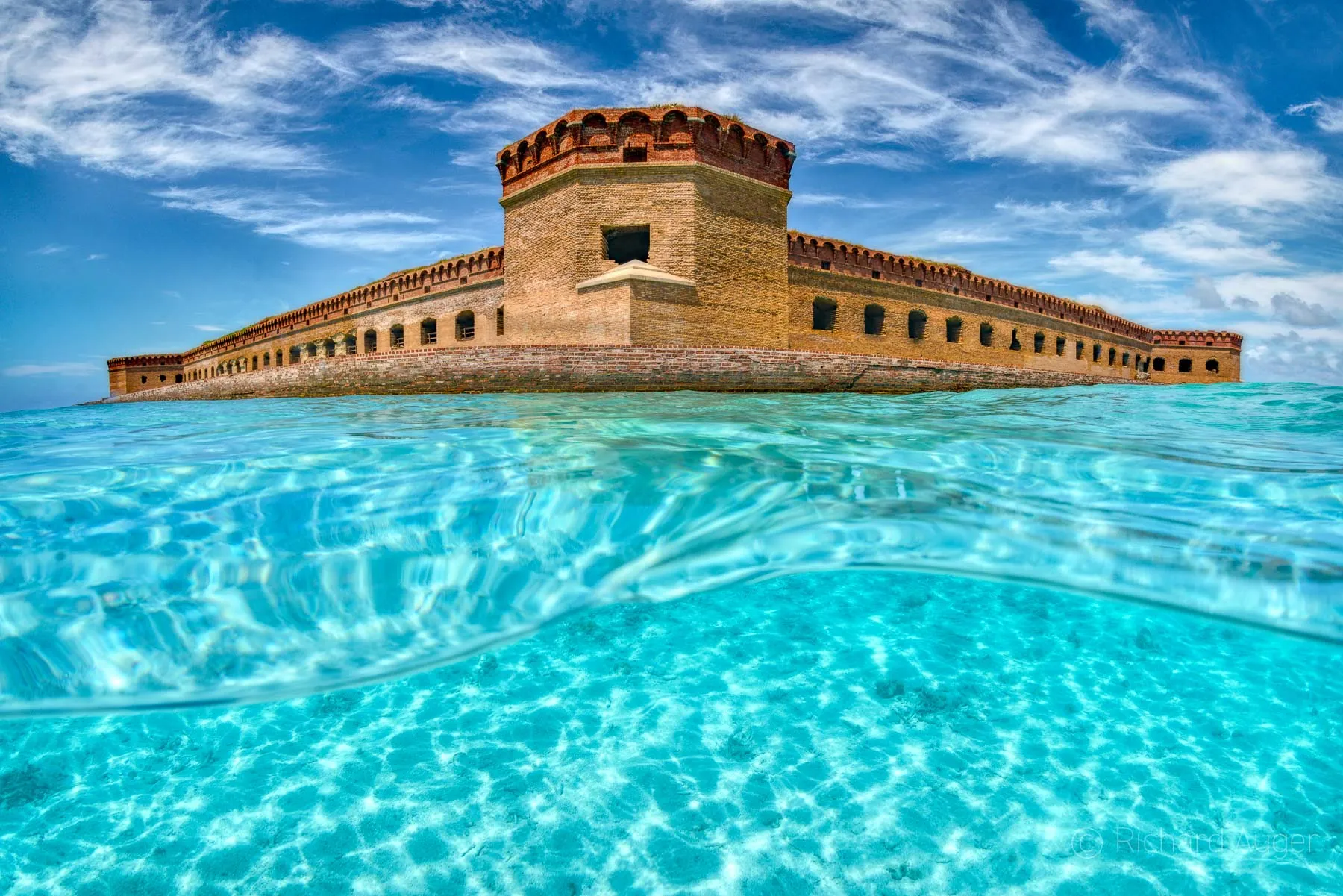
Situated nearly 70 miles west of Key West in the Gulf of Mexico, Dry Tortugas National Park boasts pristine beauty and a rich world of history. The park, accessible only by boat or seaplane, promises a unique adventure with its remote location enhancing the allure.
Best Activities
Explore a variety of activities that highlight Dry Tortugas National Park’s diverse offerings:
- Exploring Fort Jefferson: Discover Fort Jefferson, an impressive 19th-century fort on Garden Key. Guided tours illuminate the fort’s history and significance.
- Snorkeling and Diving: Jump into crystal-clear waters brimming with vibrant coral reefs. Spot marine life like barracudas, parrotfish, and sea turtles.
- Birdwatching: Marvel at the park’s avian population. Look out for species such as sooty terns, brown noddies, and magnificent frigatebirds.
How to Get There
Reaching Dry Tortugas National Park involves specific transportation methods:
- By Ferry: The Yankee Freedom III ferry from Key West offers daily trips to the park. Bookings are essential due to limited availability.
- By Seaplane: Seaplane charters provide a faster, scenic route to the park. Enjoy aerial views of the Florida Keys and the Gulf of Mexico.
- Private Boat: For those with access to private vessels, navigate to the coordinates 24.6286° N, 82.8732° W.
Exploring to Dry Tortugas requires planning, given its remote location. Get ready for an unforgettable journey, no matter the mode of transportation you choose.
Biscayne National Park
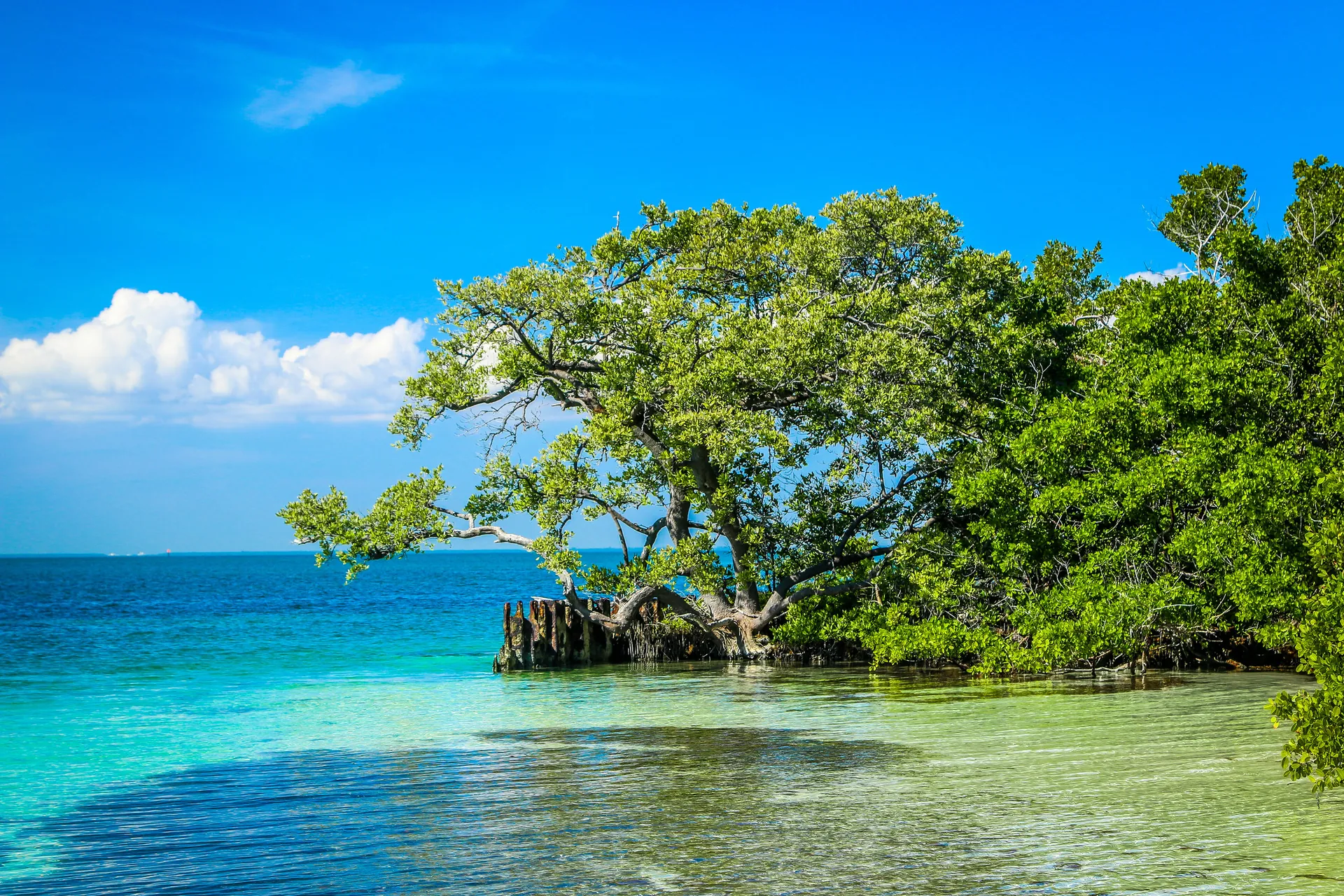
Nestled near Miami, Key Biscayne, and Homestead, Biscayne National Park sits juxtaposed between urban hustle and serene nature. This aquatic wonderland offers a refreshing escape with its breathtaking aquamarine waters and vibrant coral reefs.
Best Activities
- Boating and Fishing: Navigate the pristine waters teeming with fish and explore vibrant coral reefs. Charter services are available, catering to both novice and seasoned anglers.
- Diving and Snorkeling: Discover the park’s rich marine life, including colorful coral formations and historic shipwrecks. With guided tours, even beginners can easily explore these underwater treasures.
- Kayaking and Paddling: Maneuver through the tranquil mangrove forests and coastal areas. Rentals and guided tours often provide equipment, ensuring a safe and enjoyable experience.
- Wildlife Viewing: Encounter dolphins, manatees, and a variety of bird species. The shorelines and waters offer excellent opportunities for spotting these magnificent creatures.
- Historical Exploration: Unearth 10,000 years of human history, with sites ranging from prehistoric tribes to intriguing shipwrecks. Visit the iconic Stiltsville houses, standing on stilts above Biscayne Bay since the 1930s.
Lodging Options
While Biscayne National Park itself doesn’t offer lodging, nearby areas provide various options:
| Accommodation Type | Proximity to Park | Amenities | Price Range |
|---|---|---|---|
| Hotels (Miami) | ~25 miles | Pool, Wi-Fi, Complimentary Breakfast | $100-$300 per night |
| Vacation Rentals | ~15-30 miles | Full Kitchen, Multiple Bedrooms | $150-$400 per night |
| Campgrounds (Homestead) | ~20 miles | RV Sites, Picnic Tables, Restrooms | $20-$60 per night |
Staying in Miami or Key Biscayne grants easy access to both urban attractions and the park’s serene beauty.
Dining Highlights
- Miami’s Cuban Cuisine: Savor authentic Cuban dishes in Miami’s Little Havana, a short drive away, offering a culinary experience that perfectly complements your visit.
- Seafood Delights: Enjoy fresh seafood at waterfront restaurants in Key Biscayne, where the catch often comes straight from Biscayne Bay.
- Local Eateries: Explore casual dining options in Homestead, ranging from charming bistros to family-owned diners, providing a taste of Florida’s diverse culinary scene.
Transportation & Practical Tips
- Getting There: Reach the park via private vehicle, car rentals, or public transport options from Miami and Homestead. Boat services from local marinas provide alternative access.
- Best Time to Visit: Ideal from December to April, the dry season offers pleasant weather and optimal visibility for underwater activities.
- What to Bring: Pack sun protection, swimwear, snorkeling gear, water shoes, and a camera to capture the park’s stunning landscapes and wildlife.
- Sustainability Tips: Adhere to park guidelines, avoid disturbing wildlife, and practice leave-no-trace principles to help preserve this unique ecosystem.
- Entry Fee: Free access with potential fees for specific activities like guided tours and boat rentals ranging from $25 to $150.
- Dining: Budget $15-$50 per meal, based on chosen dining venues.
- Lodging: Costs vary by type, ensuring options for both budget travelers and those seeking more luxurious stays.
Explore Biscayne National Park for an unforgettable adventure. Jump into its natural beauty, historical charm, and diverse activities, all while comfortably staying nearby and enjoying the vibrant local dining scene. The park offers something for everyone, from thrilling water sports to serene wildlife watching.
Timucuan Ecological & Historic Preserve

Timucuan Ecological & Historic Preserve, nestled in Jacksonville, spans 46,000 acres of wetlands, waterways, and historical sites. This preserve offers a glimpse into Florida’s ecological diversity and rich history. With a subtropical climate, the best time to visit is in the cooler months from November to April.
Highlights
- Fort Caroline National Memorial: Explore this reconstruction of a 16th-century French fort, offering insights into early European settlers and their interactions with Native Americans.
- Kingsley Plantation: Visit the oldest standing plantation house in Florida, providing a powerful look at the history of slavery and plantation life.
- Theodore Roosevelt Area: Hike through one of the last unspoiled coastal hardwood forests in the southeastern United States, featuring scenic trails and abundant wildlife.
- Ribault Monument: Experience panoramic views of the St. Johns River, commemorating the exploration by French naval officer Jean Ribault.
Accommodation Tips
Nearby accommodations offer diverse options to suit every budget:
| Accommodation Name | Type | Distance from Preserve | Price Range (per night) | Amenities |
|---|---|---|---|---|
| Huguenot Memorial Park | Campground | 6 miles | $20-$30 | Beach access, picnic areas, RV sites |
| DoubleTree by Hilton | Hotel | 12 miles | $120-$180 | Pool, restaurant, fitness center |
| Jacksonville Hostel | Hostel | 10 miles | $25-$45 | Shared rooms, common kitchen |
| Marriott Courtyard | Hotel | 15 miles | $100-$150 | Pool, free Wi-Fi, restaurant |
Dining Highlights
- Singleton’s Seafood Shack: Located nearby, this spot offers fresh local seafood in a casual setting.
- Sandollar Restaurant: Enjoy waterfront dining with a varied menu, featuring seafood, steak, and southern favorites.
- The Fish Company: Known for its oysters and daily catches, this restaurant provides a relaxed atmosphere with ocean views.
- Getting there: Jacksonville’s international airport (JAX) is the closest, located about 20 miles from the preserve. Car rentals are recommended for the best exploration flexibility.
- Exploring the Preserve: Canoe and kayak rentals available for waterway exploration. Biking and hiking trails are well-marked.
- Sustainability: Participate in the preserve’s “Leave No Trace” initiative by carrying out all trash and minimizing impact on natural sites.
- Seasonal Considerations: Visit in winter for pleasant weather and fewer bugs. Summer tends to be hot and humid with afternoon thunderstorms.
Timucuan Ecological & Historic Preserve showcases Florida’s environmental and cultural heritage, providing a rich experience for nature lovers and history enthusiasts alike.
Big Cypress National Preserve
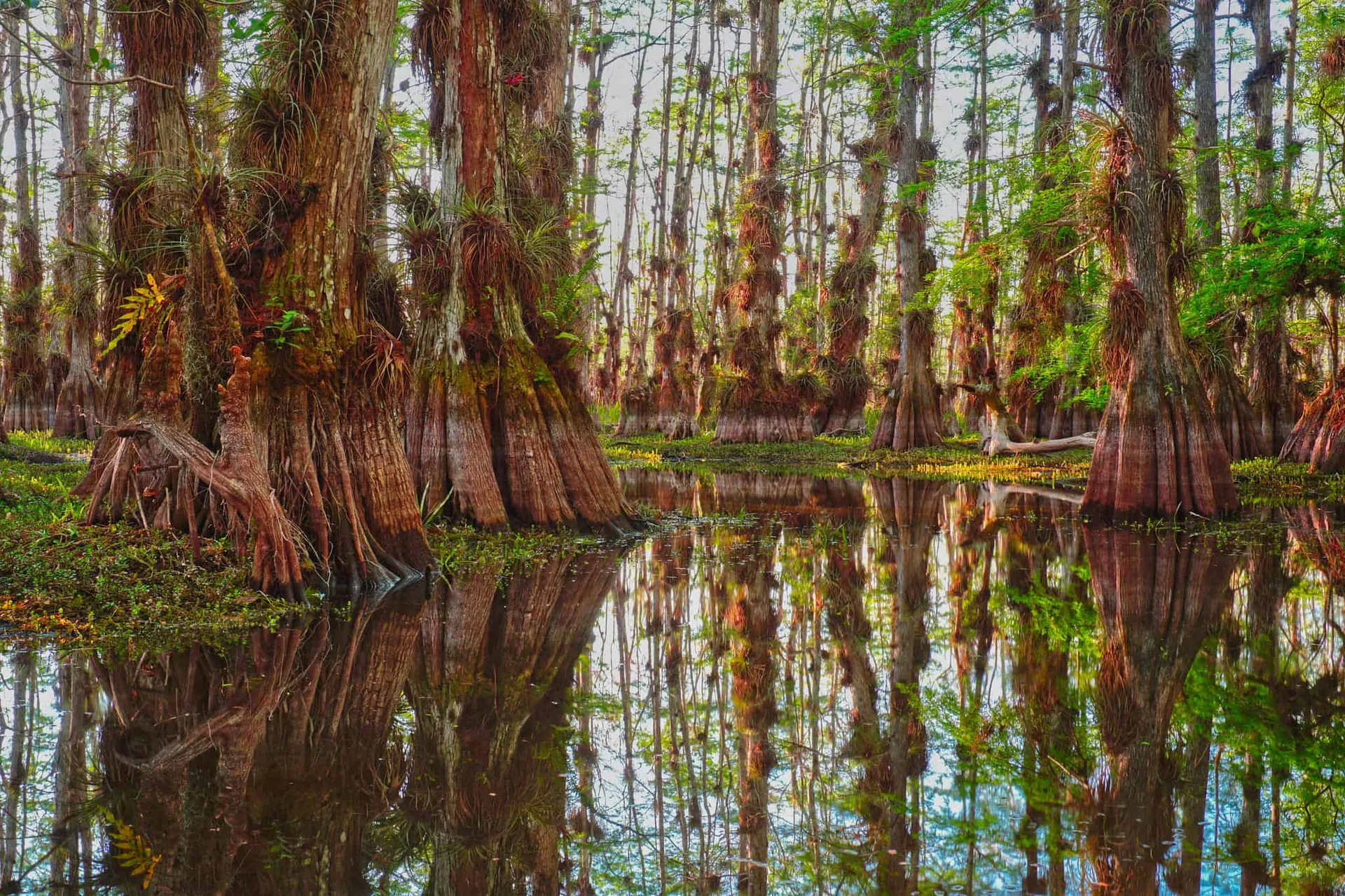
Big Cypress National Preserve offers a truly immersive experience in Florida’s wilderness. Located just north of Everglades National Park, this vast preserve of over 729,000 acres is known for its diverse habitats, including swamps, prairies, and hardwood hammocks.
Highlights
- Cypress Domes: Unique tree formations provide scenic landscapes perfect for photography.
- Loop Road Scenic Drive: A 24-mile drive offers great wildlife viewing opportunities, including alligators and wading birds.
- H.P. Williams Roadside Park: A popular spot for picnics and birdwatching.
- Off-Road Vehicle Trails: Over 23,000 acres dedicated to off-road vehicle use; permits required.
Camping Spots
- Monument Lake Campground: Offers 26 campsites, fishing opportunities, and access to nearby trails.
- Midway Campground: Features 26 sites with electric hookups, great for RVs.
- Bear Island Campground: Provides a more rugged experience; accessible only by off-road vehicles.
Top Attractions
- Kirby Storter Roadside Park: A one-mile boardwalk trail showcases the park’s swamp habitat.
- Ah-Tha-Thi-Ki Museum: Learn about the Seminole Tribe’s culture and history.
- Oasis Visitor Center: Get information, join ranger programs, and spot wildlife nearby.
Hidden Gems
- Sable Palm Trail: A lesser-known trail offering a quiet, scenic hike through diverse ecosystems.
- Gator Hook Trail: For adventurous hikers seeking an off-the-beaten-path experience.
Accommodations
| Accommodation | Type | Amenities | Cost (per night) |
|---|---|---|---|
| Monument Lake | Campground | Restrooms, picnic tables | $24 |
| Midway | Campground | Electric hookups, restrooms | $30 |
| Ivey House | Lodge | Pool, breakfast, Wi-Fi | $90 – $150 |
Dining Highlights
No in-park dining options exist, but nearby Everglades City offers local cuisine:
- Camellia Street Grill: Known for fresh seafood.
- City Seafood: Offers a variety of local fish and shellfish dishes.
- Getting There: Accessible via US 41 (Tamiami Trail) and I-75 (Alligator Alley).
- Best Time to Visit: Dry season (November to April) for fewer mosquitoes and better wildlife viewing.
- Sustainable Practices: Follow Leave No Trace principles, use biodegradable products, and stick to marked trails.
You’ll find that Big Cypress National Preserve provides a unique blend of adventure and tranquility, inviting you to explore its natural and cultural treasures.
Best Time to Visit Florida’s National Parks
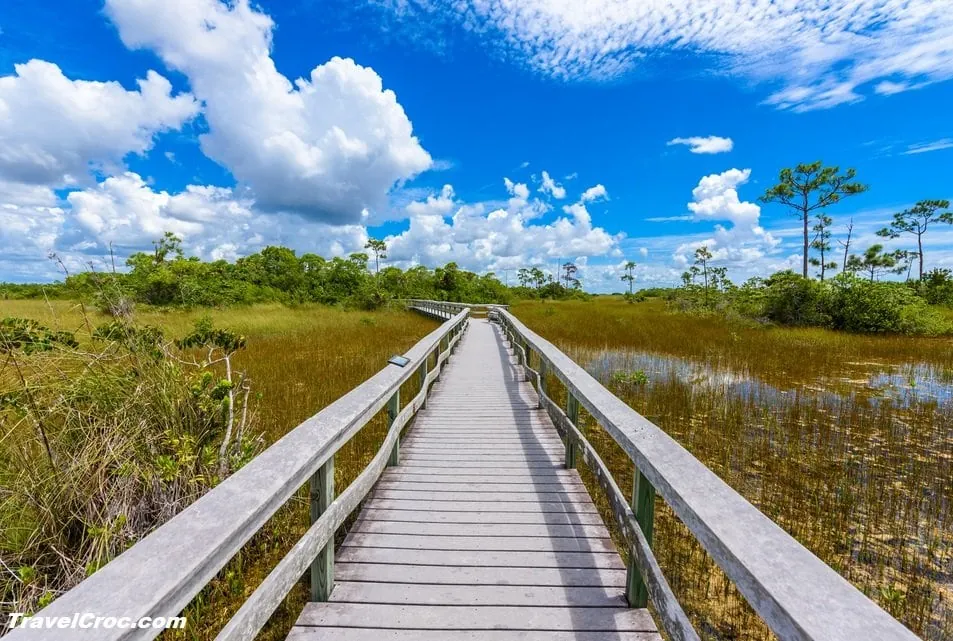
Florida’s national parks offer diverse experiences year-round.
Dry Season vs. Wet Season
The dry season, November to April, provides cooler temperatures and lower humidity. Popular parks like Everglades and Big Cypress have clear trails, abundant wildlife, and fewer mosquitoes. In contrast, the wet season, May to October, brings lush landscapes but frequent thunderstorms and higher water levels. Exploring Dry Tortugas may be riskier during storms.
Tips for Each Season
Dry Season:
- Pack Layers: Mornings can be cool, but afternoons warm up.
- Stay Hydrated: Bring ample water, especially for hikes.
- Book Early: Accommodations and tours fill quickly.
- Bring Rain Gear: Sudden downpours are common.
- Use Bug Repellant: Mosquitoes are more active.
- Check Park Alerts: Flooding can close certain areas.
Each season offers its own unique charm, inviting diverse travelers to experience Florida’s natural beauty in new and engaging ways.
Camping and Lodging in Florida’s National Parks
Camping and lodging options abound in Florida’s national parks, each offering unique experiences. Whether you prefer a rustic campground or a comfy lodge, you’ll find diverse accommodations suited for every taste.
Popular Campgrounds
Everglades National Park
- Long Pine Key Campground: Located near the Homestead entrance, it offers 108 drive-up sites and is close to hiking trails.
- Flamingo Campground: Offers waterfront sites, eco-tents, and a nearby visitor center. Ideal for canoeing and kayaking.
Dry Tortugas National Park
- Garden Key Campground: Basic tent camping on Garden Key. Provides picnic tables, grills, and a scenic view of Fort Jefferson. Accessible only by boat or seaplane.
Big Cypress National Preserve
- Bear Island Campground: Located in a remote area, it’s best for off-road vehicle enthusiasts. Offers primitive camping with no hookups.
- Monument Lake Campground: Features 26 RV sites with restrooms and drinking water. It’s an excellent spot for spotting wildlife.
Options Near the Parks
Biscayne National Park
- Not available within the park boundaries, but nearby Key Largo offers hotels, motels, and private rentals. Examples include Key Largo Bay Marriott Beach Resort and various vacation rentals.
Timucuan Ecological & Historic Preserve
- Within Jacksonville, you’ll find a range of lodging options. From campgrounds at Little Talbot Island State Park to hotels like Omni Jacksonville Hotel, the area caters to diverse needs.
| Park | Campgrounds | Nearby Lodging |
|---|---|---|
| Everglades National Park | Long Pine Key, Flamingo | Hotels in Homestead and Florida City |
| Dry Tortugas National Park | Garden Key | Not applicable (remote) |
| Big Cypress National Preserve | Bear Island, Monument Lake | Hotels in Everglades City |
| Biscayne National Park | Not available | Hotels in Key Largo |
| Timucuan Preserve | Campgrounds at Little Talbot Island | Hotels in Jacksonville |
Florida’s national parks boast diverse camping and lodging options, providing comfortable and unique ways to explore nature’s wonders.
Tips for a Successful Visit
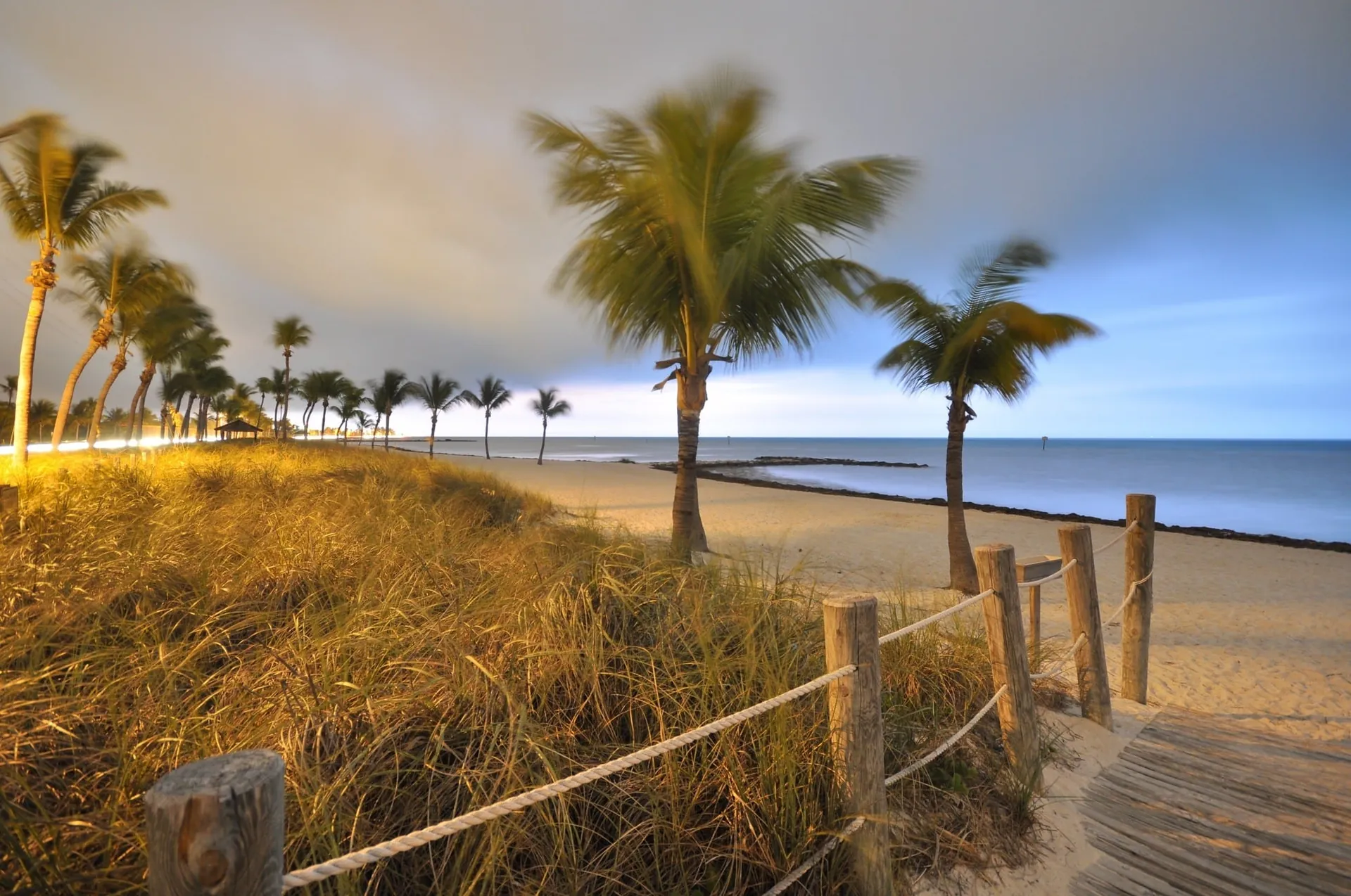
Packing Essentials
Preparing the right gear ensures a smooth trip to Florida’s national parks. Start with lightweight, moisture-wicking clothes to manage the humidity. Bring sun protection, including SPF 50+ sunscreen, sunglasses, and a wide-brimmed hat. You’ll need a reliable insect repellent for mosquito-prone areas. Carry a refillable water bottle to stay hydrated, especially in the heat. Don’t forget sturdy hiking boots if you plan on exploring trails like Anhinga or Shark Valley.
Safety Recommendations
Think safety first when visiting these natural landscapes. Always follow park guidelines and stay on marked trails to avoid hazards. In areas like Everglades National Park, be aware of wildlife such as alligators and avoid feeding or approaching them. For aquatic activities in Biscayne or Dry Tortugas, wear a life jacket and check weather conditions beforehand. Keep emergency contacts handy and let someone know your itinerary, especially in remote areas. If you visit during the wet season, monitor weather alerts for thunderstorms or hurricanes.
Conclusion
Florida’s national parks offer a wealth of experiences, from exploring lush wetlands to diving into vibrant coral reefs. Whether you’re hiking through the Everglades or snorkeling in Biscayne, each park provides unique adventures and stunning natural beauty. By planning your visit according to the best seasons and packing the right essentials, you’ll ensure a memorable and safe trip. Embrace the diverse landscapes and rich history that Florida’s national parks have to offer, and you’ll create unforgettable memories in these remarkable natural treasures.
Frequently Asked Questions
What makes Florida’s national parks unique?
Florida’s national parks offer diverse landscapes, from subtropical wilderness and wetlands to vibrant coral reefs and historical sites, providing unique experiences like hiking, wildlife observation, and aquatic activities.
Which is the largest national park in Florida?
Everglades National Park is the largest subtropical wilderness in the U.S., covering over 1.5 million acres, and is home to rare species like the American crocodile and Florida panther.
What are some must-see attractions in Everglades National Park?
Key attractions include the Anhinga Trail, Shark Valley, and the Gulf Coast Visitor Center, along with hidden gems like Mahogany Hammock and Nine Mile Pond.
How do I get to Dry Tortugas National Park?
Dry Tortugas National Park is accessible only by boat or seaplane. Transportation options include the Yankee Freedom III ferry, seaplane charters, and private boats.
What activities can I do in Biscayne National Park?
Biscayne National Park offers activities such as boating, fishing, diving, snorkeling, kayaking, and wildlife viewing. It’s known for its aquamarine waters and vibrant coral reefs.
What is the best time to visit Florida’s national parks?
The best time to visit is during the dry season, from November to April, when the weather is cooler, trails are clearer, and wildlife is more abundant.
Are there camping options in Florida’s national parks?
Yes, popular campgrounds include Long Pine Key and Flamingo in Everglades National Park, Garden Key in Dry Tortugas National Park, and Bear Island and Monument Lake in Big Cypress National Preserve.
What should I pack for a trip to Florida’s national parks?
Pack essentials like lightweight clothing, sun protection, insect repellent, sturdy hiking boots, life jackets for aquatic activities, and rain gear, especially during the wet season.
What are the dining options near Florida’s national parks?
Dining options range from local seafood restaurants in nearby towns to the diverse cuisine in Miami, including Cuban food and fresh seafood.
How can I practice sustainable travel in Florida’s national parks?
Follow park guidelines, stay on marked trails, minimize waste, use eco-friendly products, respect wildlife, and support local businesses to ensure your visit is environmentally friendly.

